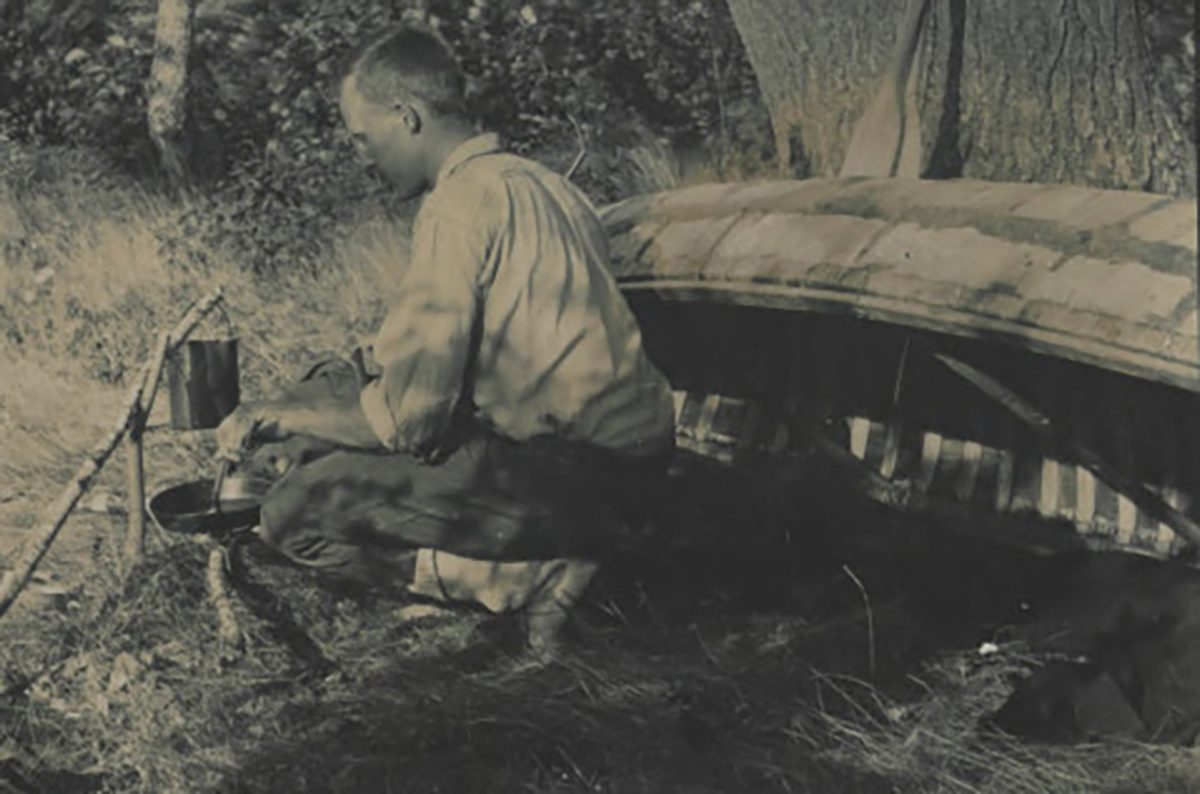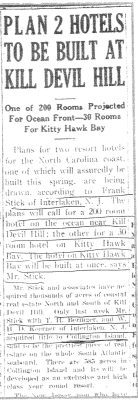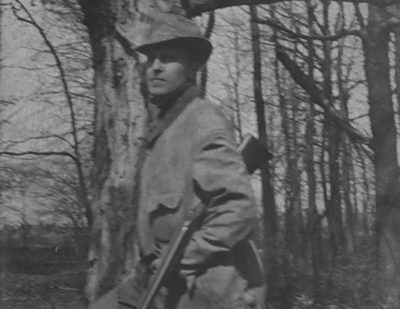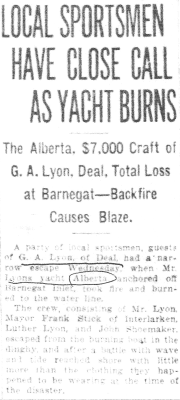

Frank Stick was in search of two things when he arrived on the Outer Banks in the 1920s: adventure and money. He found enough adventure to fill a lifetime but like many Bankers on the isolated barrier islands, he scrambled to pay the bills. Once one of the largest landowners, with property from Kitty Hawk to Hatteras, the artist turned developer lost many of his holdings during the Great Depression. Stick eventually recovered and developed the much-admired Southern Shores community with his son David and other partners. A complex man of shifting interests and unwavering opinions, Stick was both a conservationist who played an instrumental role in the formation of Cape Hatteras National Seashore and an avid land speculator who wrote of turning the Banks into a playground for tourists. This is his story.
Chapter One: The Outdoorsman
After finishing a new book, “The Geography of Risk,” in 2018, I began rooting around for my next project. I thought I might write about the Outer Banks. I had been coming to Currituck for over three decades at that point and had watched it grow from a modest seashore retreat to a modern-day coastal playground with ever larger and more luxurious “cottages” and amenities. I was both intrigued and, I suppose, alarmed by these changes. I didn’t want the Banks to morph into another coastal suburb with big-box stores, chain restaurants, and row after row of grid-style houses. I wanted the old unpretentious Banks, with their rough edges, rogue charms, and breathtaking views. I thought there might be a story and wanted to know more.
Supporter Spotlight
Discovering things is how I work. I rarely begin with an outline. I prefer to get dirty, prowling around in archives and spending countless hours online reading old newspaper stories. In public settings, writers assume a pose of confidence and control. But don’t believe it. A week didn’t pass in which I wasn’t hounded by the thought all my research might be for naught. The Outer Banks, really? Who wants to read a modern history of the Banks? And then one coffee-deprived morning, I stumbled upon Frank Stick.

Of course, I had no idea who Frank Stick was, why he mattered, or what he had to do with the Outer Banks. But there he was, lurking in a yellowed 90-year-old newspaper clipping about a grand new resort he planned to build near the border of Kitty Hawk and Kill Devil Hills. Frank talked about building beach cottages and hotels, and how his plan marked a new beginning for the long-ignored Outer Banks, then one of the poorest places in North Carolina. Local newspaper editors ate it up. Change was at hand, they proclaimed, and not a moment too soon. It was the 1920s, after all, and the markets were roaring, jazz was in the air, optimism rampant.
“Look at Florida,” roared W.O. Saunders, the irascible editor and publisher of The Elizabeth City Independent. “Why can’t the Outer Banks with all of its natural assets be the next Florida? We can fashion a national playground for Americans of all ages, who will come here and spend their money, creating jobs for anyone who wants one. It will be a new golden age, perhaps even a Paradise.”
For reasons I can’t explain, I became obsessed with Frank Stick. Every day I learned a little more of his improbable story – artist, outdoorsman, gadfly, dreamer, developer, speculator — and how he had landed on the Banks in mystery and shadows. What I couldn’t decide was whether Frank (he was now just Frank to me) was a hero or merely posing as one? His motivations were complicated. He was a naturalist who filled miles of beaches with vacation houses. A conservationist who eagerly speculated in land and promised investors big profits. An artist, coveted for his illustrations, who abandoned his art to be a real estate man.
Just when I would think I knew him, some other facet of his personality would reveal itself and I would find myself fumbling for purchase again.
Supporter Spotlight
“Stick was a unique individual, characterized by his extreme versatility,” wrote Michael F. Mordell, author of an early biography of Stick, the artist.
That sounded about right. Frank painted, drew, and sculpted. He designed homes and landscapes. And he wrote feverishly, if often baroquely, about a wide range of subjects. At times, he exaggerated, claiming to be a native of the Banks, or took credit for projects he didn’t lead. I imagine it had to do with his competitive personality and solitary upbringing. Frank was uniquely self-possessed and rarely short of confidence. It brimmed in his art and cast a long arc over his family. And over the course of four decades, it had a powerful impact on the Outer Banks.
~
Frank Leonard Stick was born in the railroad town of Huron, South Dakota, in February 1884, but at an early age moved to Sioux City, Iowa, then to Oglesby, Illinois. As a young boy, he vanished into the woods to hunt, fish, and explore. Initially, these forays lasted hours. Then days. Then weeks. Smart but bored with formal schooling, he headed to the woods of northern Wisconsin, where he worked as a camp cook. By the time he was a teenager, he was expert at camping and guiding. In time, he moved deeper into the forests and mountains of the West, traveling as far as Yellowstone in Montana. Grainy photos show Frank dressed in a buckskin shirt and hat, with an ever-present neckerchief and pipe – oh, and an elk strapped across his back.

“I am not able to remember back to a period when I was not engaged in one way or another in getting my full measure of happiness from the out-of-doors,” Stick wrote in the journal Outdoor America, published by the Izaak Walton League of America.
In the early 1900s, Frank found a way to marry his passion for nature and wildlife with a future profession. He began drawing, sketching, and painting landscapes and hunting scenes. In 1904 he sold his first painting of a fisherman landing a bass to Sports Afield magazine for $10. Over the next two years, he contributed 75 illustrations to the magazine, according to Mordell. An expert angler, Frank also wrote stories about his fishing exploits for national publications and later in life would co-author a book on surfcasting.
Around the age of 22, Frank was invited to join Howard Pyle’s Brandywine School of Art in Wilmington, Delaware. Pyle was arguably the nation’s best-known illustrator. Instruction was free, informal, and lasted as long as the instructor and budding artist deemed necessary. Frank stayed three years and was surrounded by an array of talent, including N.C. Wyeth, Maxfield Parrish and W. H. D. Koerner, who would become a great friend. It was at Wilmington that Frank also met a petite and exuberant model, 18-year-old Ada Maud Hayes, who would become his partner in both business and life.

Frank and his new bride returned to the woods of northern Wisconsin, where they lived in a simple, Thoreau-style cabin on Squirrel Lake. Frank continued to hunt, fish and paint. His illustrations graced the covers of Field & Stream and other magazines. Others highlighted popular calendars, then a lucrative source of money for illustrators. Frank was a commercial and financial success, with as much work as he wished. Yet, as would become a familiar pattern throughout his life, Frank grew restless. Perhaps tired of solitary life, he decided to move the family east, closer to the big cities with their magazines and publishing houses.
In 1917, Frank, Maud, and their young daughter Charlotte moved to the tiny borough of Interlaken, near the seashore resort of Asbury Park, in Monmouth County, New Jersey. Named after the exclusive resort in Switzerland, Interlaken was approximately midway between New York and Philadelphia, centers of the publishing industry. Importantly, it also bordered Lake Deal, a magnet for migratory waterfowl, and was only a short hike to the Atlantic Ocean and Barnegat Bay, for fishing. Known as an artist’s colony, the small borough attracted painters, poets and actors. Frank built a large Georgian-style mansion and art studio on the banks of Lake Deal and called it Pine Cove.

Today, the Asbury Park many people know is the one Bruce Springsteen sang about in his seminal first album, “Greetings from Asbury Park,” a gritty, down-on-its-luck, fading seashore resort. But at the turn of the last century Asbury Park was very much alive and thriving. A popular destination for actors, politicians, and wealthy industrialists. Frank seemed to know all of them. Some he met through his art. Others through his adventures hunting and fishing. He also gave talks to any group that asked and frequently wrote about his exploits for the local papers.
One of his closest friends was Van Campen Heilner, a silver spoon scion of an anthracite coal fortune, who lived in nearby Spring Lake. Heilner often appeared in the newspapers in a pith helmet and was a well-known explorer, writer, and filmmaker associated with The Museum of Natural History in New York City. Ernest Hemingway considered Heilner one of the finest anglers in the world and named one of the characters in “A Farewell to Arms” Nurse Van Campen, an inside joke. In 1920, Stick and Heilner co-authored a pioneering work on surfcasting, “The Call of the Surf.”
Along with G. Albert Lyon, an inventor who made millions patenting bumpers and wheel covers for the nascent automobile trade, Stick and Heilner traveled from Maine to Florida hunting and fishing. In one memorable incident, Stick was fishing on Lyon’s yacht, Alberta, near Barnegat Inlet, when the yacht suddenly exploded and burned to the waterline. Lyon, reported The Asbury Park Press, “made a picturesque figure, garbed in a suit of pajamas and hip boots” as he launched himself into the inlet’s notoriously dangerous currents. Stick escaped by dinghy, telling a reporter that he didn’t mind losing his fishing tackle but greatly regretted he was unable to recover a “fine string of big bluefish.”

Frank also befriended Zane Grey, the popular author of “Riders of the Purple Sage”and other Western novels. Grey edited articles Stick wrote for Outdoor America. In turn, Frank illustrated some of Grey’s books and magazine stories. Grey was an avid angler and kept a camp in the Florida Keys, the Long Key Fishing Club. Frank became a frequent guest, sometimes staying for weeks at a time. He landed so many bonefish Grey included him as a character in his 1922 story, “The Bonefish Brigade,” which recounted one of their many fishing adventures.
By the mid-1920s, sales of Grey’s books topped $1 million, making him America’s first millionaire author. Meanwhile, in one year alone, Stick reportedly sold over 150 illustrations. Even so, Frank complained that his art was beginning to feel cookie-cutter; editors were asking him to produce the same scenes over and over. He also worried that his illustrations of hunters glorified slaughtering the very waterfowl and animals he intended to celebrate. “Of course the main reason I quit art,” he told Maud, “was that I was fed up on that hunting stuff.”
Something had to change.
Next in the series: The nature lover turns speculator







